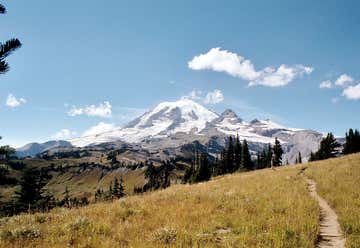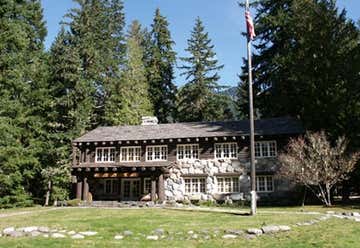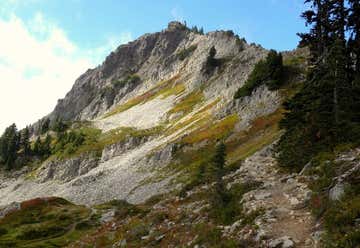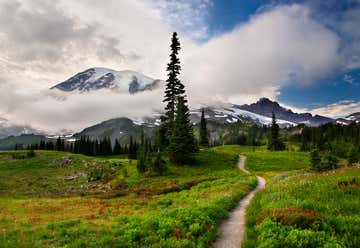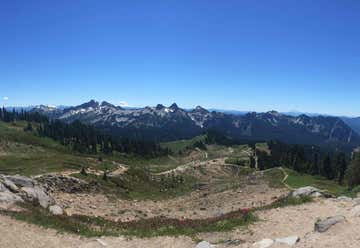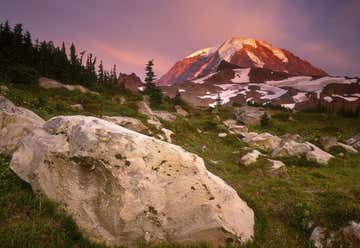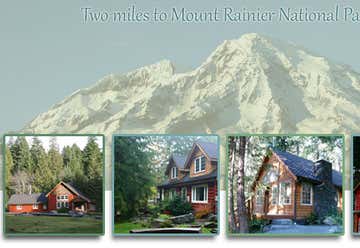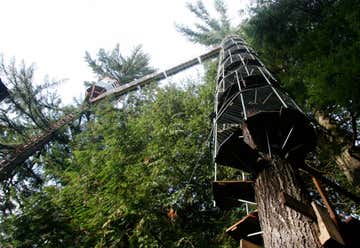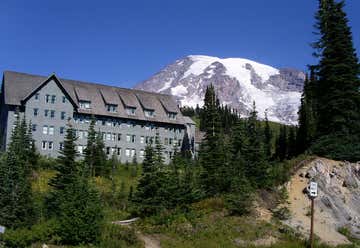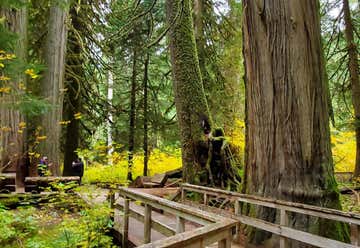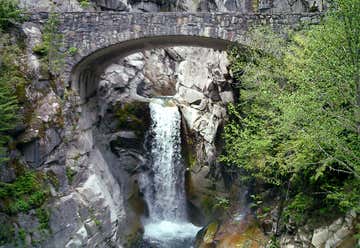Sure, Mount Rainier National Park's biggest feature is... well, Mount Rainer, but there's so much more to the park than the peak... although if you're an avid hiker, you won't find a better place for stunning scenery. It was originally set aside because of the lovely forests surrounding the mountain, but of course, Rainier and its stunning views, subalpine meadows, volcanic past, and many glaciers is an important natural wonder to preserve. While all that is awesome, you don't need to be a mountain-climber to appreciate the park. Still not sure? Just check out these hidden gems!
Tips for visiting Mount Rainier National Park:
-Climbing Mount Rainier itself is no east feat. Nearly 10,000 people attempt to conquer the 14,411 feet peak... and only half are successful. Come prepared if you want to make it to the top of Rainier (and remember that you'll need a permit)... otherwise, there are tons of easier hikes that are just as pretty! -The park is open 24/7, but roads and visitor centers close at night and on certain days during the winter. Call ahead, especially if it's during the snowy seasons. -Speaking of snow, the park's Paradise Valley is one of the snowiest places on Earth, getting about an average of 53 feet of powder per year. When it isn't covered in snow, Paradise features its famous wildflowers... but expect to find snow on the ground here well into July. That being said, winter sports like snowshoeing and tubing are incredibly popular in Paradise. It even has a snow-play area! -Dress in layers, since the temperature in the park is cool to begin with, and it cools off even more the higher in elevation you go. Yes, even in the summer! Just in case. -Be prepared to get to the Paradise Visitor early, especially during summer weekends. Otherwise, you might have to hoof it a mile from the further lot to the visitor center. Plus, you can spend the morning checking out the visitor center exhibits before it gets too crowded, then head out on a hike once you're done!
The Wonderland Trail is a footpath around Mount Rainier that's over a century old, and it's a breathtaking 93 miles long. The hike is definitely not for the faint of heart. But, it's one of those hikes of a lifetime. The hike takes you to high and low elevations, and can take up to ten days. It's primarily open for hikers from early summer through September. You'll need to sort out permits, organize camping, and be prepared for various climates. But, with valleys of wildflowers and insanely beautiful landscapes, this is a hike you'll never forget.
Longmire was once the park's HQ back when it was first established in 1899. Before that, James Longmire had used the property as a homestead, a lodge, and a resort, complete with mineral springs. While it's no longer the center of park activity, it's still got its history going for it-- it's been designated a Historic District, and now has a museum. There's also the old administration building, which exemplifies that rustic "parkitecture" style that was super popular in National Parks in the 1920's, and there's also the National Park Inn, Mount Rainier's oldest lodge, which is open all year round.
It doesn't get any more classic than Whittaker's Bunkhouse! This former logging bunkhouse has been converted into a retro-inspired motor lodge. The rooms have rustic, Pacific Northwest flair and are super reasonably prices, plus the joint is super close to the park. They even have an onsite cafe where you can warm up with a hot drink and some breakfast. If you're looking for super economical accommodations, they have hostel-style bunks, as well. If you stay here, take the chance to explore the logging town of Ashford... it's super cute!
If you're less experienced climbing mountains but still want to try your hand at conquering one, try the hike up Plummer Peak. It's a fairly easy, 2.6 mile round trip trail that can be accomplished in about 5 hours, making it a nice day hike... but since it's the 7th tallest peak in the Tatoosh Range, it's still pretty impressive, offering views that seem to go on forever and lovely subalpine meadow sights!
If you're not up for a hike, there are loads of scenic overlooks just off the park's roads. Stevens Canyon Road features Inspiration Point, which has ample parking and incredible views of Rainier. If you keep going down Stevens Canyon Road, you'll reach another scenic point at Reflection Lakes, where you can get a different view of the mountain... as a reflection on the crystal clear water!
Colorful wildflowers like lupines, mountain heather, scarlet paintbrush, cascade asters and bistort dot the lush grass, carved stone stairs make the trail feel like something from a fairytale, and majestic peaks covered by glaciers provide endless photo ops. All in all, you can take the whole looping trail, which climaxes at the stunning Panorama Point, for a 5.4 mile journey that should last around 4 hours.
Paradise is the most popular spot in the park, for many reasons. Paradise Jackson Visitor Center is located here, and during the winter, this side of the mountain receives the most snow, making it the perfect destination for skiers and winter sports enthusiasts. If you visit during spring or summer, you'll be treated to views of the valley covered in blooming wildflowers. There are lots of trails in this part of the park, so grab a map at the visitor center to guide the way.
A slightly more intense hike is the Spray Park Trail. It's 6 miles round trip, and offers views of glaciers and the Spray Falls for which the trail is named, in addition to the extensive meadows for which the park is known. The trailhead (at the bare-bones Mowich Lake walk-in campground) is a little more remote, so the trail is less crowded than many others in the park. Plus, there's a bit of elevation gain on this trail, so be prepared.
If you're looking for a resort experience, or a private cabin, Copper Creek is your best bet! They describe their aesthetic as "upscale roughing it", which fits in with the rustic cabins (most of which have private hot tubs, and if you're staying in the lodge, you can sign up for a time to use the hot tubs located in the forest!) Plus, the restaurant is a great little place to grab a nice meal. They bake their breads fresh every day, and hand-roll the crusts for their famed blackberry pies!
Don't freak out with excitement, but Mount Rainier has its very own treehouse rental! Cedar Creek Treehouse is probably one of the most fun treehouses in the country, with giant swings, suspension bridges, even an observatory. You'll be sleeping 80 feet off the ground, among the branches of a stately cedar tree. There's a working kitchen and heat, but no running water or outlets, so it's more similar to camping, but the chance to sleep atop the forests of the Pacific Northwest is absolutely worth it. Pro tip: if you can't get a room, or aren't in the mood to rough it, call and ask the owners for a tour. It's seriously one of the coolest treehouses in the country.
Tucked in the drier, sunnier, southeast corner of Mount Rainier National Park, Ohanapecosh Campground is so chock full of color that not even Crayola can compete. From the crystal clear aquamarine of the Ohanapecosh River to the vibrant evergreens to the reddish hues of tall cedars, Mother Nature busted out her finest pigments at this campground – and you can park your RV right in the thick of it.
There's a 2.7-mile trail that leads from the Ohanapecosh Campground to Silver Falls, where the super-blue river makes its final tumble before heading out to the Pacific. Fed by creeks high in the Cascade Mountains, the Ohanapecosh River maintains a bright blue color unseen anywhere else in the park. The one downside: its high-altitude H2O means that this rushing river is pretty frigid even in the hottest months.
For the classic National Park lodge experience, book a stay at the Paradise Inn. It was built in 1919 and has all the rustic, vintage charm you could ever want. From the massive fireplace and floral light fixtures in the lobby to the lack of wifi and TVs, it feels a bit like stepping back to a simpler time. If you need a quick meal or just want to stock up on souvenirs, they have a cafe and gift shop onsite as well.
Looking for an easier trail? The Grove of the Patriarchs winds through a forest of massive Douglar firs, cedars, and hemlocks, all covered in moss. It's a totally different experience than the fields and switchbacks you'll see hiking in the Tatoosh Mountains, but this quiet, peaceful hike is just as worth doing.
The Mt. Rainier Railroad Dining Company is one of the most unique eateries in the area. Located in an old train car, there's a restaurant that serves up old-school dishes like elk and buffalo burgers and fried chicken, a lounge with an outdoor beer garden, and the Hobo Inn, a collection of cabooses where you can spend the night. There's nothing quite like immersing yourself in the comfy, kitschy environment!
Longmire is super neat, but it's not the only awesome visitors' center in the park.You can't beat the views at the Sunrise Visitor Center and Lodge; it's the highest point in the park accessible by vehicle, so the drive up is stunning. A drive allows you to cover more ground and see more than a hike would, although this is a good place to find a few trails if you do want to explore the park on foot-- the hikes here have more variety than simply walking towards the mountain, and it's less crowded.
Determining the best time of year to visit Mount Rainier National Park is actually a little complicated. Summer is great for camping and hiking, with temperatures that range from the 40s to the 80s. Winter, even though it brings incredible amounts of snow, isn't bad either: as stated above, Paradise sets up a snow-play area, and the mountains do look lovely covered in snow. Spring and fall are cool and mild, but often bring good amounts of rain. Not that that's unusual for this part of the country, but do remember to bring boots, a rain slicker, and other rain gear along just in case!


